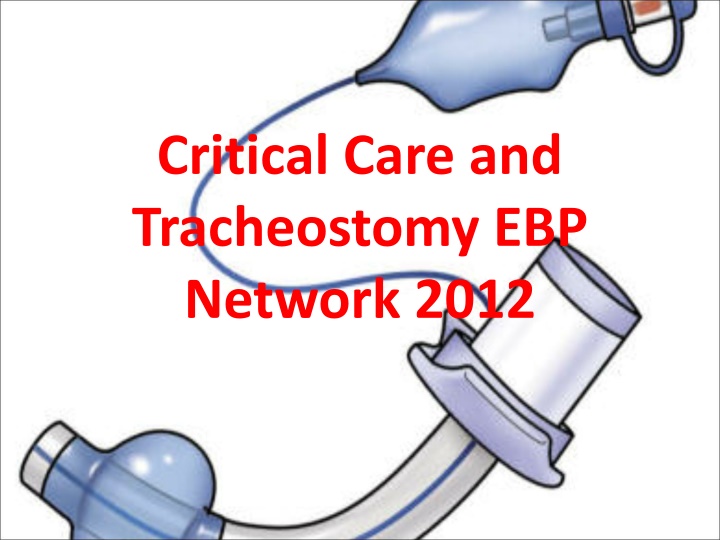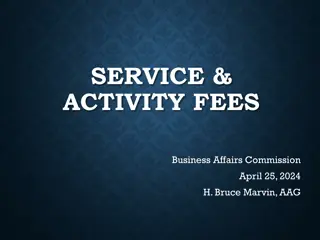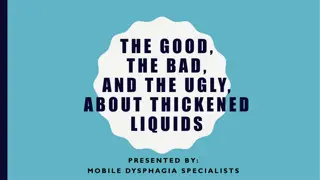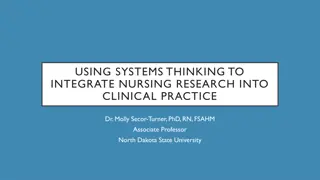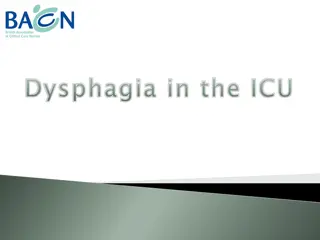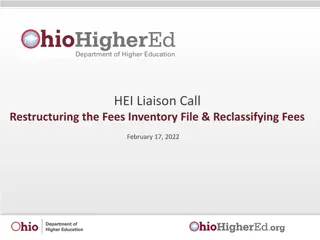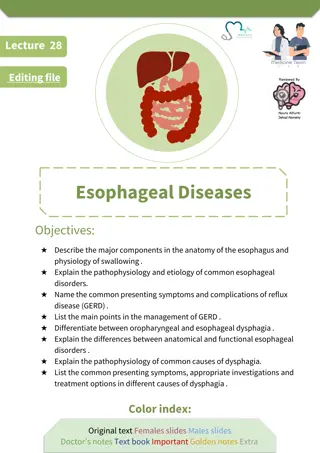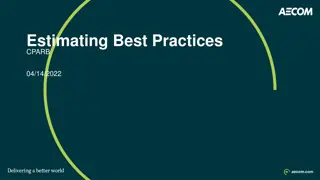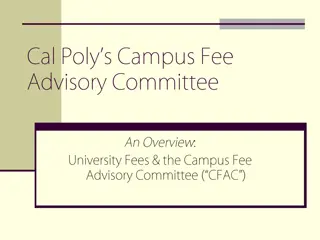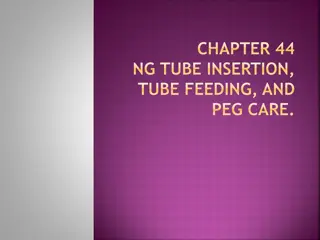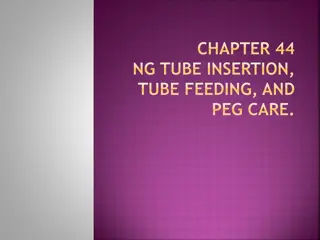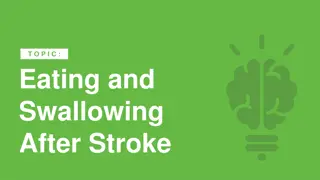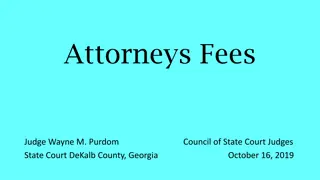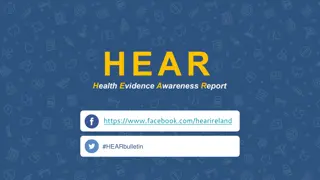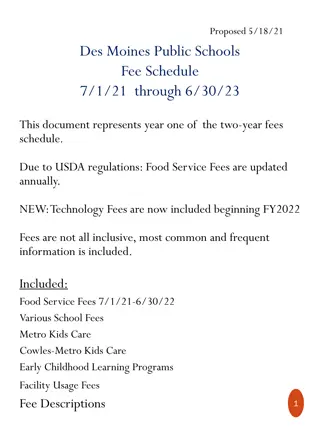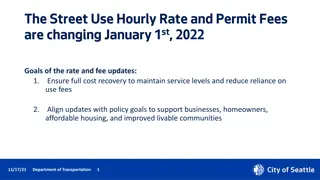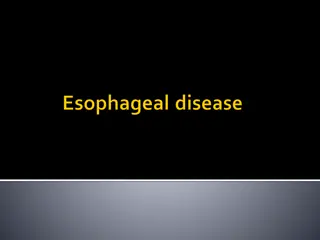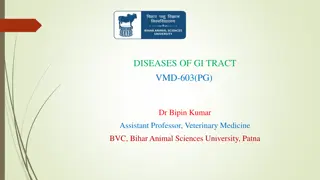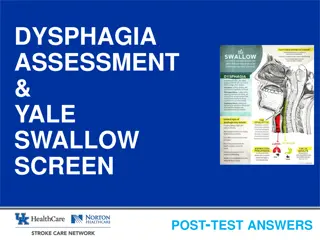Evidence-Based Practice in Critical Care: Focus on FEES in Dysphagia Management
This presentation outlines the activities of the Critical Care and Tracheostomy EBP Network in 2012, including a review of the year, changes in leadership, and discussions on the use of Fiberoptic Endoscopic Evaluation of Swallowing (FEES) in critical care settings. Various research articles are discussed, highlighting the effectiveness of FEES as a diagnostic tool for identifying dysphagia in critical care patients despite some discrepancies in data and methodological limitations in studies.
Download Presentation

Please find below an Image/Link to download the presentation.
The content on the website is provided AS IS for your information and personal use only. It may not be sold, licensed, or shared on other websites without obtaining consent from the author.If you encounter any issues during the download, it is possible that the publisher has removed the file from their server.
You are allowed to download the files provided on this website for personal or commercial use, subject to the condition that they are used lawfully. All files are the property of their respective owners.
The content on the website is provided AS IS for your information and personal use only. It may not be sold, licensed, or shared on other websites without obtaining consent from the author.
E N D
Presentation Transcript
Critical Care and Tracheostomy EBP Network 2012
PRESENTATION OUTLINE Year in review 2012 CAT topic E3BP project
YEAR IN REVIEW Change in leaders (thank you to Eva and Klint for their hard work) 50% increase in membership 6 meetings this year Critical care and tracheostomy discussion list serve remains active with just under 200 members. Included clinical case discussion to each meeting following member survey Interstate collaboration and pending SPA poster presentation in 2013 Reviewed CAPs on in critical care patients does intubation effect laryngeal health ? , with aim to complete CAT early 2013
CAT TOPIC 2012 FEES IN CRITICAL CARE Background to CAT there are differences between sites utilising FEES for management in critical care. Some sites are keen to introduce the use of FEES in critical care and it would be ideal to have evidence to justify service establishment. Clinical question was formed to assist in examining the documented evidence supporting the use of FEES to identify dysphagia. Is FEES an effective diagnostic tool in critical care for identifying dysphagia?
Article Level Participants Method Diagnostic tool Outcome measure Results Support for clinical question? Hafner et al (2008) 4 553 critical care pts (incl tracheostomised pts) Prospective interventional study Screening risk for dysphagia in ICU post extubation Detection of silent aspiration in 69.3%, 22.9% decannulated. Yes Self generated FEES protocol Hales et al (2008) 4 25 critical care tracheostomised pts Prospective observational study Clinical bedside swallow Ax Detecting penetration and aspiration- FEES more reliable Yes FEES Ax (Rosenbeck Scale) Ajemian et al (2001) 4 48 critical care (non-trache) pts Prospective observatonal study Dysphagia detected in 56% pts Yes FEES within 48 hrs of extubation 25% pts silently aspirated McGowan 4 4 ventilated , tracheostomised pt s with cuff inflated Case series pilot study FEES Ax (Rosenbeck Scale) had normal swallow, aspirated, 2/4 had laryngeal penetration Yes Noordally et al (2011) 3 21 critical care pts Prospective comparison study Clinical Ax and FEES within 24hrs of extubation ? Each swallow component rated on scale of 1-3 and then rating compared between tools. Methodological limitations. Disregard study (non- tracheostomised) Attempted to compare parameters of swallow between FEES, MBS and clincial ax Above evaluations repeated at 48hrs and 10/21 stable patients also recieved a MBS ?Statistical correlations of ratings Barquist et.al 2001 3 70 critical care patients Prospective comparison study with concurrent controls FEES Clinical assessment of swallowing Incidence of post extubation pneumonia between patients with clinical and FEES in patients intubated > 48 hrs Limted study with many methodological limitations. Disregard study
COMMENTS Discrepancy in data recorded in some articles Limited uniformity between the patient populations in these studies (some tracheostomised, some ventilated, post extubation etc) Speech Pathologist was not consistently part of the investigating teams Inter-rater reliability was an issue
CAT bottom line In the critical care population, limited, low level evidence suggests that FEES may be useful in identifying dysphagia. In some studies, FEES has been shown to be more sensitive than bedside Ax in detecting silent aspiration. Further robust research is required in order to support the use of FEES in preference to clinical bedside ax or MBS in the critical care setting
CAT bottom line : application to clinical practice Confirms what we know about FEES ie : FEES may be useful for detection of silent aspiration Useful for both tracheostomised and non tracheostomised patients Suggests that FEES can be useful for non-mobile and medically unstable patients Consistent with results of NSW Health Draft Tracheostomy Clinical Practice guideline (2012) recommendation: Where objective assessment of swallowing is required a FEES may be considered as alternative objective assessment to a VFSS. A FEES has been demonstrated to have greater sensitivity than clinical assessment alone to detect aspiration and is particularly useful in critical care environments. FEES may allow earlier commencement of oral intake.
2012 E3BP PROJECT E3BP review Background Collection in the clinical setting Themes from collation Future directions in the clinical setting &beyond
E3BP TRIANGLE Best external evidence Clinical expertise Best internal evidence (from clinical practice) Best internal evidence (from client factors & preferences)
BACKGROUND TO E3BP PROJECT 2011 CAT involved review of the literature on the effect of tracheostomy on swallow function CAT bottom line - low level evidence to suggest that a tracheostomy tube does not cause dysphagia; rather, the dysphagia is attributed to the underlying diagnoses and co morbidities The group identified a significant gap in evidence versus clinician opinion/practice Decided to use E3BP to enable holistic decision making around trache care Group then circulated and analysed an online survey to NSW speechies to gauge level of knowledge and ideas on current practice Survey was also distributed to Vic tracheostomy interest group
E3BP collection in the clinical setting Group brainstorming session and development of preliminary data collection table some concerns from the group regarding the sensitivity and robustness of the tool. Group members and their departments started data collection Some members of group attended Beyond Basics EBP workshop. Some discussion with Elise Baker. its not research ! Include the mess and keep collecting! Refined table online during data collection. Easy to use, not time intensive, aim to make it a part of clinical assessment.
Trache Trache Insitu Post-Decannulation (First swallow Ax post-decannulation) Time Summary (Last swallow Ax pre-decannulation) Reason for Trache insertion Trache type insitu at time of Ax Size 6 7 8 9 Other: Portex Shiley Other brand: Fenestrated Non- fenestrated Cuffed Uncuffed Cuff up Cuff down Speaking Valve Capped Respiratory support: Trache mask + vent Trache mask only Diet + Fluids recommendation Diet + Fluids recommendation Swallow Ax (A) Swallow Ax (B) Airway patency Respiratory/ pulmonary toileting Prolonged ventilator wean GCS Assessment type: Bed-side FEES MBS Posture: Upright; Semi-upright; supine Delayed onset of pharyngeal initiation >1 swallow per bolus Reduced hyolaryngeal excursion Other: Signs of aspiration: Cough Throat clearing Wet vocal quality Increased SOB Reduced oxygen saturation Stained secretions (food/fluid) NBM NGT/TPN NGT/TPN + oral intake Oral intake only Thin Fluids Nectar/mildly thick Honey/moderately thick Pudding/extremely thick Puree Minced Soft Full Small amounts (specify): Other: Swallowing strategies: Assessment type: Bed-side FEES MBS Posture: Upright; Semi-upright; supine Delayed onset of pharyngeal initiation >1 swallow/bolus Reduced hyolaryngeal excursion Other: Signs of aspiration: Cough Throat clearing Wet vocal quality Increased SOB Reduced oxygen saturation Stained secretions (food/fluid) NBM NGT/TPN NGT/TPN + oral intake Oral intake only Thin Fluids Nectar/mildly thick Honey/moderately thick Pudding/extremely thick Puree Minced Soft Full Small amounts (specify): Other: Swallowing strategies: No. of days trache insitu : No. of days between Swallow Ax (A) and Swallow Ax (B): Has there been a change in swallow function? No change Improvement Decline If swallow function has improved, what may have contributed to this? Trache decannulation Improved general medical status
E3BP data trends to date N = 36 6 sites completed (other sites interested but not included at this stage) 5 tertiary sites, 1 metro site Data collected over last 6 months (May-Nov) 35 clinical Axs (only 1 MBS, no FEES) Last ax with trache insitu and first ax post decannulation Average of 12.86 days between ax s Reason for trachy insertion : 30/36 prolonged vent weans, 4/36 low GCS, 1/36 airway patency, 1/36 respiratory toilet PRELIMINARY TRENDS IN DATA see table
Cohort = 36 Was there a change in swallow between last Ax with trache insitu and first assessment with trache removed? (Eg. Change to diet recommendations, less repeat swallows, reduced aspiration/penetration signs?) YES = 22 No = 14 What caused the improvement? 5 15 2 trache decannulation medical improvement Combination other factors? Anxiety, upper airway irritation
WHERE TO FROM HERE ? Continuation of E3BP data collection to increase our body of internal evidence with future trend analysis Continued liaison with Victorian tracheostomy interest group. Joint submission of poster abstract for 2013 SPA conference re member survey Finalise the CAT on the effect of intubation on laryngeal health Hosting tracheostomy education day 2013
